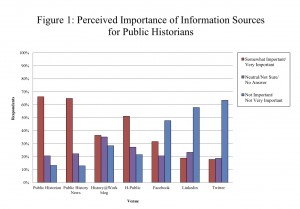Speaking of the survey (Part 3): Diversity and challenge in public history's information landscape
22 October 2012 – editors
 This is the third in a series of posts about the findings of our summer 2012 survey on the current state and possible future directions of The Public Historian journal and other NCPH media.
This is the third in a series of posts about the findings of our summer 2012 survey on the current state and possible future directions of The Public Historian journal and other NCPH media.
—
from Rob Townsend, Deputy Director, American Historical Association:
The Public History Readers Survey demonstrates the wide array of information sources that now dot the landscape of our professional lives, and the challenges that the National Council on Public History faces as it considers the future of its publishing program. Of the 626 respondents to the survey, 88% indicated they value at least one of NCPH’s print and electronic publishing venues, but they differed widely in their preferences.
To assess the information needs of public historians, the survey asked about a wide array of print, electronic, and social media outlets, including the print publications of NCPH, the History@work blog, NCPH listservs, Facebook, LinkedIn, and Twitter. Notably, 76.2% of the respondents indicated that they valued one or both of the print publications of NCPH, while 72.7% valued one or more of the electronic resources.
There was substantial overlap between the “print consumers” and “digital consumers,” but 19.9% of the respondents who thought the print publications were important saw no value in the various electronic outlets. Conversely, 16.0% of the respondents who valued one or more of the digital resources saw no value in the print publications of NCPH, which highlights the challenges for the Council as it tries to develop a suite of information services that will serve all its constituents.
The immediate purpose of the survey was to assess The Public Historian. Most of the respondents indicated that they value the journal, though the response was a bit tepid. Less than a third (32.6%) reported that the journal was “very important” for information about the public history field and profession, while 33.5% said it was “somewhat important” and 17.7% were neutral or not sure. Another 13.3% indicated that the journal was not an important source.
Not surprisingly, perhaps, opinions tended to vary depending on the membership status of the respondent, as 85.6% of NCPH members described the journal as important, while only 29.9% of nonmembers found similar value in TPH.
There was also a high level of correlation between the level of the respondent’s degree and the perceived importance of the journal, as 80.9% of the respondents holding the PhD cited the importance of the journal, compared to 62.8% of the respondents with MA degrees.
Respondents who valued The Public Historian also tended to be information omnivores, as 96.6% of them indicated at least one of the other publication venues was important. Aside from Public History News (which was important to 64.9% of the respondents), only the H-Public listserv was considered important by a majority (51.1%). But 75.6% of the respondents valued two or more of the other information outlets.
Though still in its infancy, the History@Work blog was marked as important by 36.4% of the respondents. Among the social media outlets, 31.6% of respondents indicated Facebook was important, while LinkedIn received high marks from 18.8% of respondents, and Twitter garnered support from 17.9%. Unlike the other NCPH publishing outlets, all three of the social media outlets received more negative than positive marks (Figure 1).
Despite the apparent interest in eliciting information through the Internet, initial consumption of The Public Historian remains quite traditional. Among the respondents who described how they read current content, 63.8% of the respondents said they only read the journal in print, and another 23.7% said they read TPH in both print and online forms. Only 12.5% reported they read current issues online.
There was very little difference between the age cohorts on this question. Two-thirds (66.3%) of the respondents aged 18 to 30 reported they only read the journal in print—virtually the same rate (68.1%) as among the respondents age 45 and older.
The electronic version of the journal does have substantial value as an archive, however. Among the 381 respondents who reported consulting back issues of the journal, 75.9% reported using the electronic version of the journal, as 28.9% consulted both print and electronic copies, while 47.0% only looked online.
Viewed as a whole, the survey of public history readers offers a rich snapshot of the complex and changing landscape for information in the field, but also the challenges NCPH faces as it charts the future of its publishing program.





1 comment